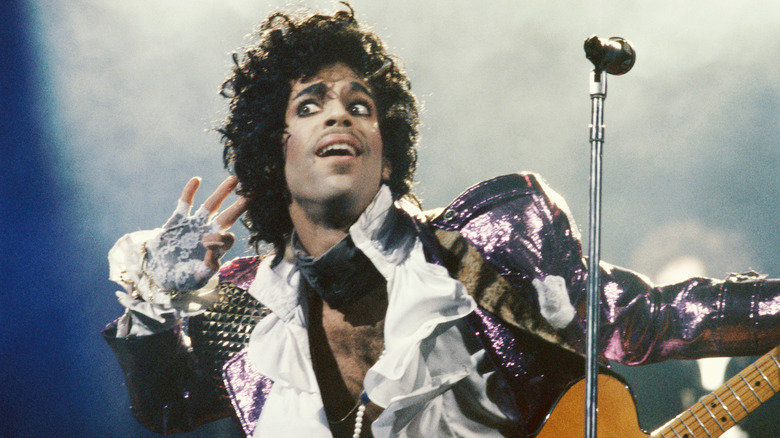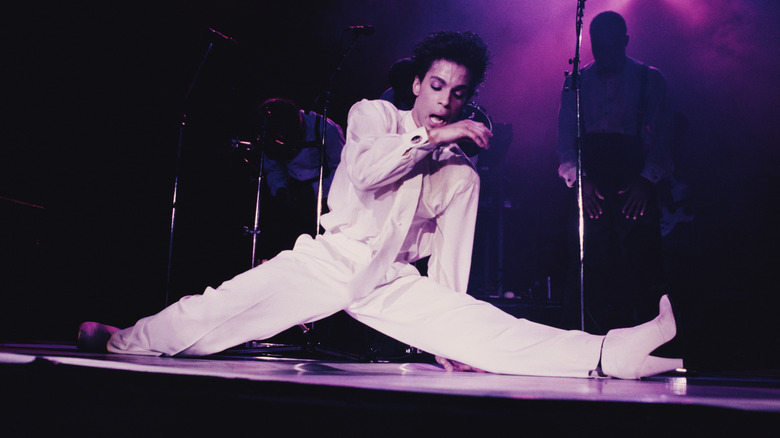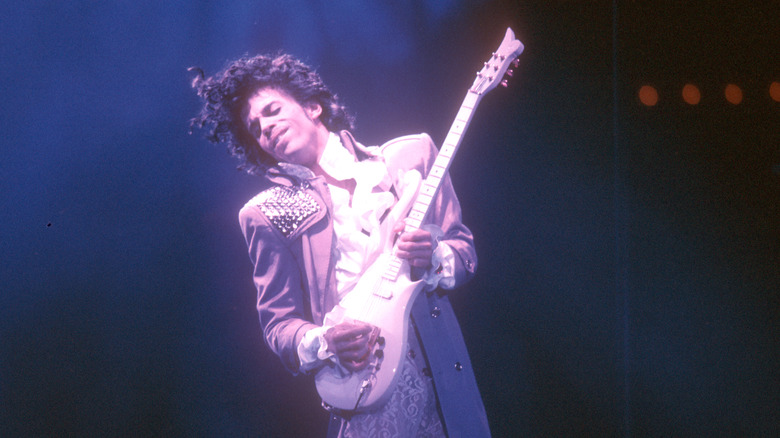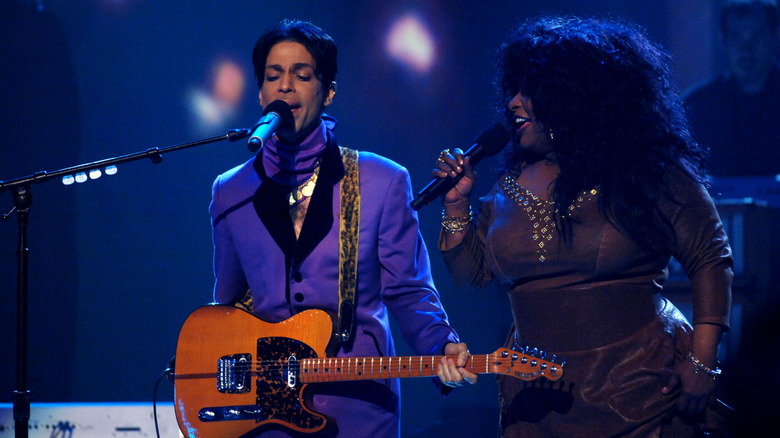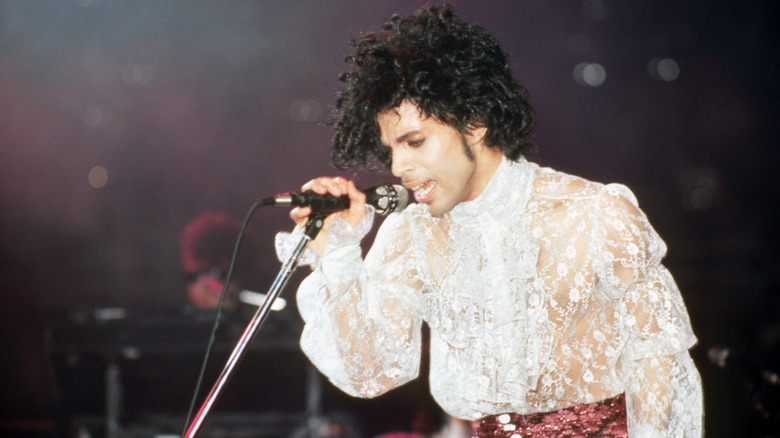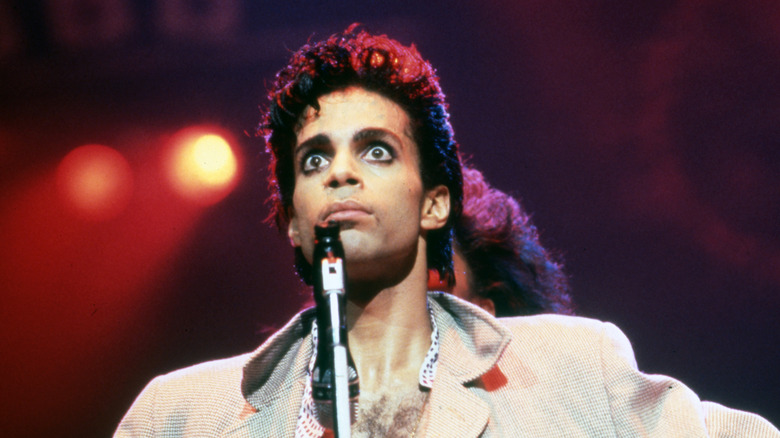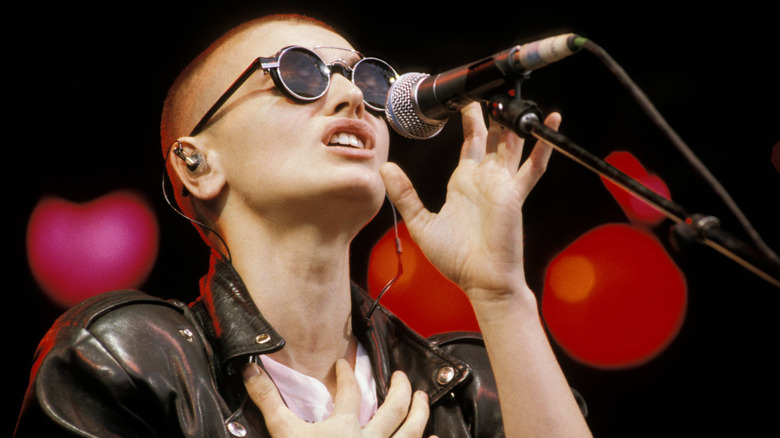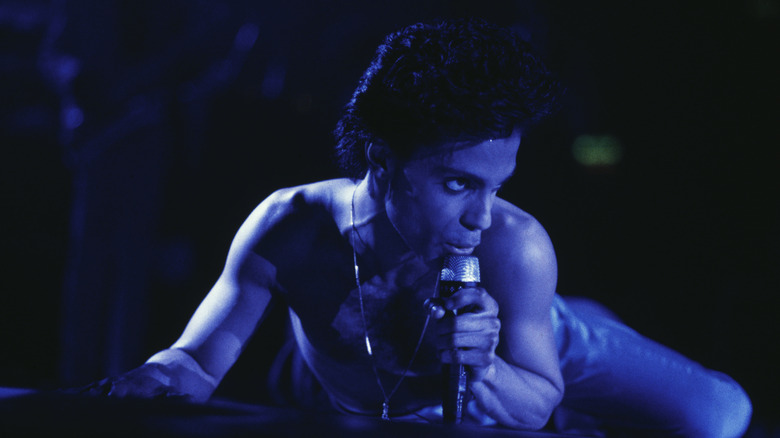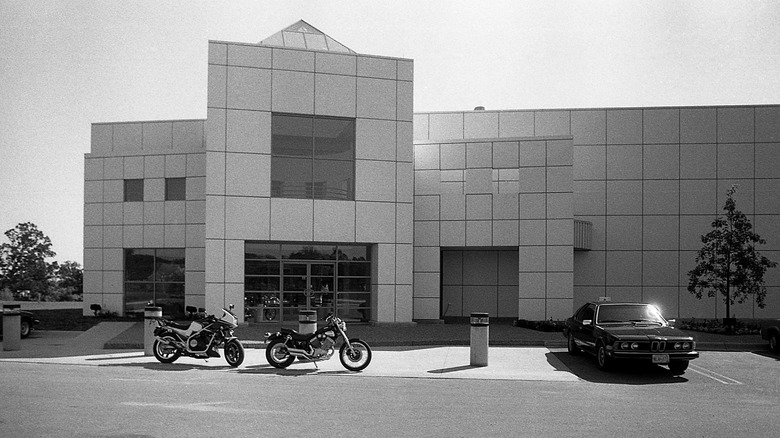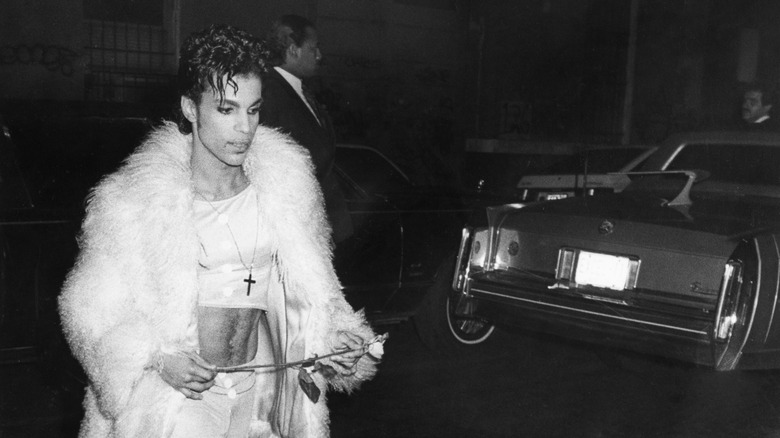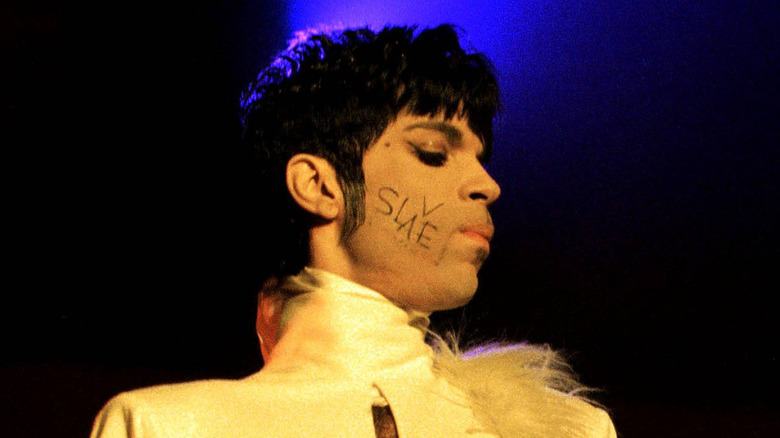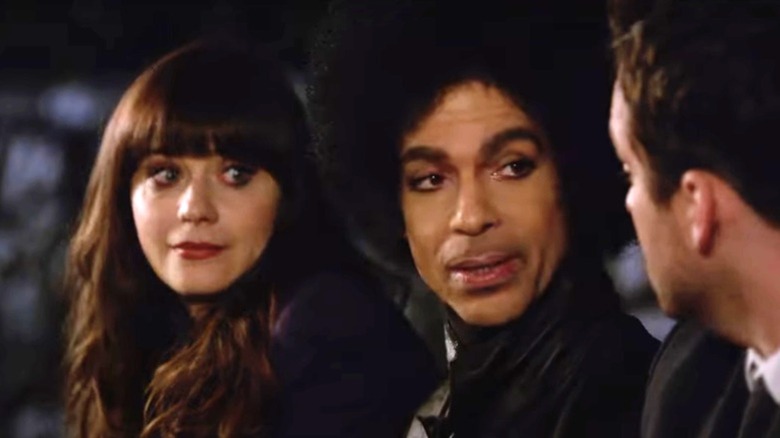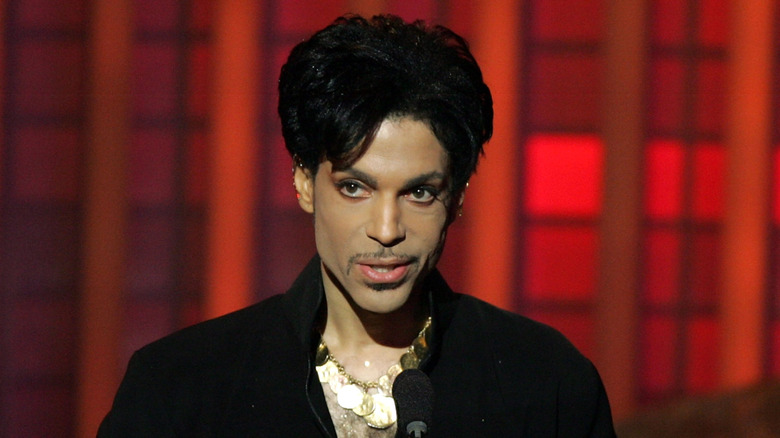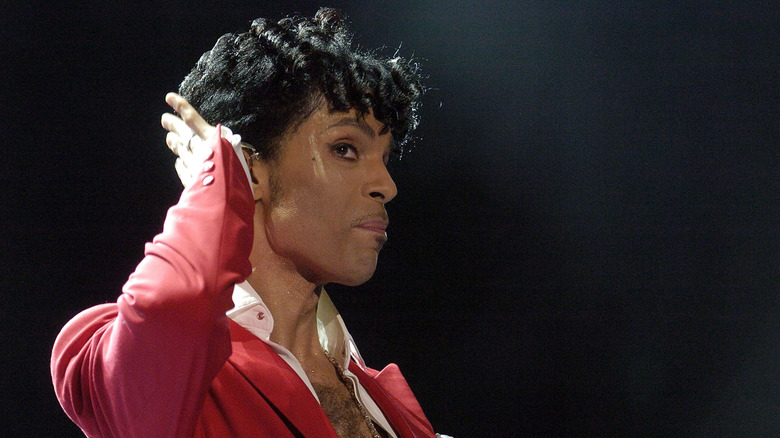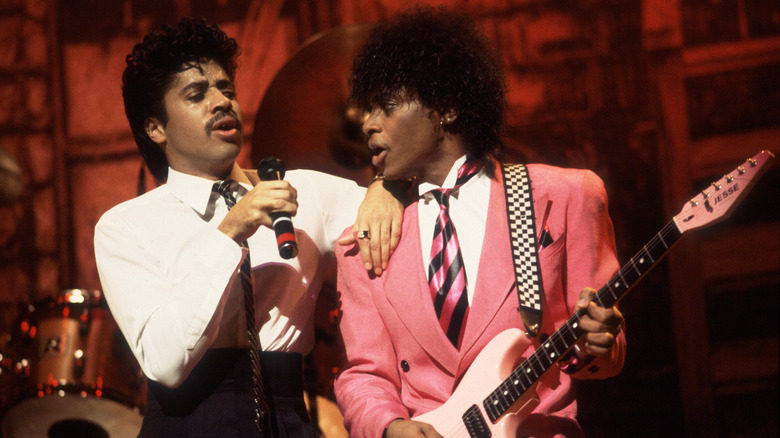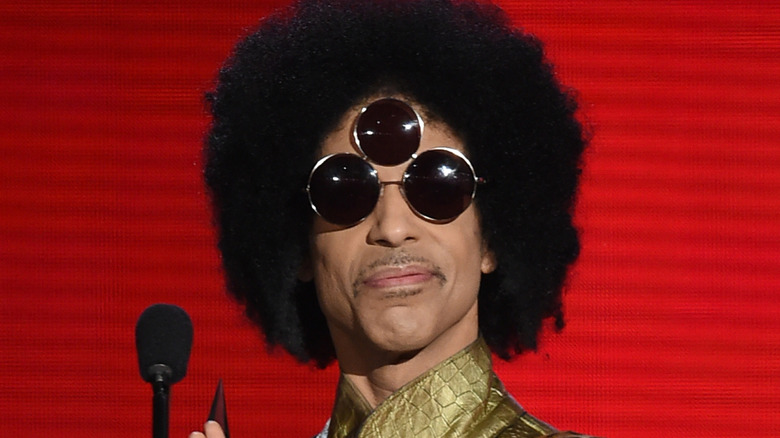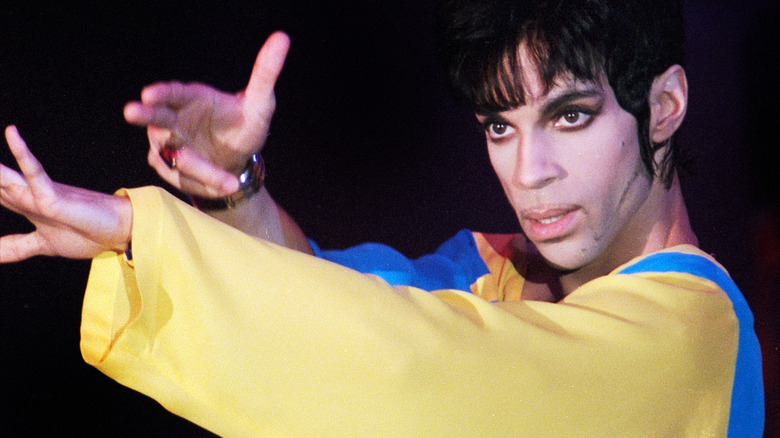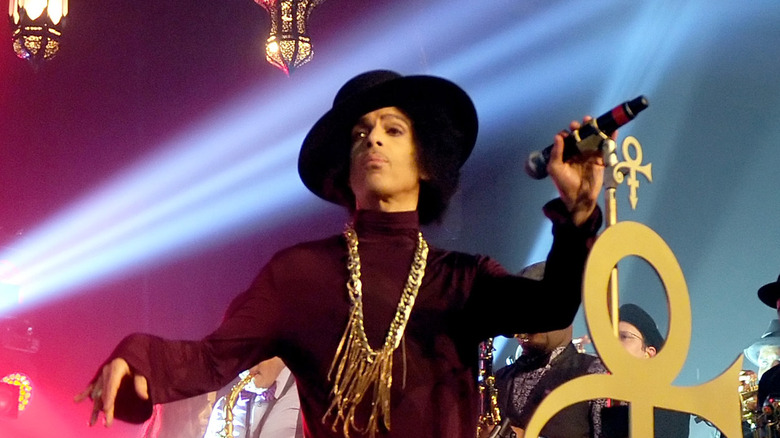Why There Will Never Be Another Musician Like Prince
"My name is Prince, and I am funky. My name is Prince, the one and only." With those boastful words kicking off the 1992 track "My Name is Prince," the rock star known by the one-name moniker of Prince issued a swaggering declaration that was as cocky as it was 100% undeniably true.
Born Prince Rogers Nelson, he burst onto the music scene in the late 1970s, and remained a cultural force to be reckoned with for decades. An exceptionally gifted musician, singer, songwriter, and bandleader, Prince redefined rock stardom with an ever-evolving sound that blended elements of dance-floor funk, stadium rock, and soulful R&B, creating a unique style that was unmistakably his own.
While he experienced unimaginable triumph, the real-life story of Prince was ultimately tragic, ending in 2016 due to an accidental fentanyl overdose at the far-too-young age of 57. Before then, though, he'd already accomplished far more than a lifetime's worth of work, while also keeping many secrets he didn't want people to know. When learning more about this intriguing and often enigmatic personality, it will become clear why there will never be another musician like Prince.
Prince could seamlessly blend genres
When growing up, Prince was something of a musical sponge, listening to any and all music he could and absorbing it. From Jimi Hendrix to Grand Funk Railroad, and from Sly and the Family Stone to the Jackson 5, his influences coalesced. As a teenager, he formed a band, Grand Central, and began getting booked at school dances and proms, which meant he had to learn how to play the Top 40 hits of the day in order to appeal to as many teenagers as possible.
With all those varied influences co-mingling, Prince grew comfortable operating within a wide range of musical genres. That came to be evident in his eclectic body of work, spanning from rock anthems to longing ballads to straight-out funk to full-on psychedelia. Many of his hits blended these seemingly antithetical styles into a cohesive whole that can only be described as Prince music, while also demonstrating the artificiality of the way the recording industry categorized music within strictly defined groupings.
Perhaps the most obvious example of Prince's genre-bending is "Funknroll," which seamlessly merges guitar-driven rock with R&B, funk, and dance music. That ultimately proved to be Prince's superpower, allowing him to attract a diverse array of fans with music that transcended race and genre.
His stage performances were electrifying
While Prince the recording artist was bold, experimental, and brilliant, Prince the live performer was explosive. Borrowing from the dance moves of the likes of rival 1980s hitmaker Michael Jackson and Mr. Dynamite himself, James Brown, Prince commanded the stage like few other performers. This was on full display during his brief (just 12 minutes) but utterly incendiary performance at the 2007 Super Bowl halftime show, with a set list that included his own hits ("Let's Go Crazy," "Baby, I'm a Star"), funked-up covers of Credence Clearwater Revival ("Proud Mary"), and Bob Dylan via Jimi Hendrix ("All Along the Watchtower").
Prince was also a tough-as-nails bandleader who expected the same precision from his fellow musicians that he expected from himself. Inspired by Brown's practice of fining a band member who hit a bad note, he began to do the same thing, once fining his bass player $1,200 for a single gig. In a 2011 interview with The Guardian, Prince characterized himself as a "loving tyrant. I'm probably the hardest bandleader to work for, but I do it for love."
Even though he'd long ago attained immense stardom, Prince was also aware of how fleeting it could be. When he hit the stage, fans could be guaranteed that he wouldn't be phoning it in. "I play each show as if it's the last one," Prince said.
Prince could shred the guitar with the best of them
When Rolling Stone compiled its 2004 list of the 100 greatest guitar players of all time, Prince was conspicuous by his absence. For anyone who had ever witnessed him rip into a guitar solo, this omission was as insulting as it was baffling.
Later that same year, he appeared at the Rock and Roll Hall of Fame induction ceremony. Among those being inducted was the late Beatle George Harrison, and Prince was part of the all-star band onstage for a live performance of Harrison's "While My Guitar Gently Weeps." Standing alongside a group of rock royalty that included Tom Petty, ELO's Jeff Lynne, and Steve Winwood, Prince stepped up to take on the song's iconic guitar solo. Fiercely unleashing on a Fender Telecaster, Prince blew the roof off the place with fiery fretwork that is still considered legendary — and was an act of vengeance aimed at Jann Wenner, Rolling Stone's then-publisher and co-founder of the Hall of Fame.
In an interview with The New York Times, the show's producer, Joel Gallen, recalled that Prince's solo during the rehearsal was tame and muted compared to what he unleashed at showtime, leaving everyone stunned. "And the rest is history," said Gallen. Petty was also particularly impressed with Prince's musicianship. "He just burned it up," Petty told the Times. "You could feel the electricity of 'something really big's going down here.'"
He was a multi-instrumentalist who played every part on his debut album
Prince was still a teenager when he was signed to a record deal with Warner Bros., and entered the studio to record his 1978 debut album, "For You." Released when he was 19, "For You" was distinctive in that it not only introduced Prince's unique sound, but also because he'd played every single instrument on the album — all 27 of them.
Interviewed by Guitar Player, Prince was asked whether he found it easier to play all the instruments himself, rather than show other musicians how to recreate what he was hearing in his head. "It's not easier, but when I play all the instruments I'm not as greedy," he said, explaining how that was why he tended to show off more in concert than in recordings. "I'm more greedy when we play live," he added with a laugh.
The credits on "For You" read, "Produced, arranged, composed, and performed by Prince." That feat made him the youngest artist in the label's history to produce his own album and play every instrument on it. As Prince told Insider Magazine in 1978, he viewed the recording studio the way an artist views a blank canvas. "The instruments are colors on a palette, the mikes and board are brushes," he explained. "I just keep working it until I've got the picture or rather the sound that I heard inside my head when it was just an idea."
Prince self-produced his own albums and those of other artists
When Prince signed his deal with Warner Bros., one of the stipulations was that he would never have to work with a producer; he believed that the only person who could produce Prince was Prince. He held fast in that, and produced every single album he released prior to his death. Winning that right, however, was hard-fought; Warner Bros. execs were extremely hesitant to hand the reins to the newly signed artist, and pushed for Earth, Wind & Fire's Maurice White to produce his debut album.
Prince's skills behind the soundboard were in hot demand, and he produced albums for other artists, ranging from Chaka Khan to Sly and the Family Stone bassist Larry Graham. Asked by Guitar Player if there were any guitar players that he wanted to produce, he singled out guitar legend Carlos Santana. "I love his playing — especially on his early albums," Prince said.
He also produced albums for those with whom he'd worked, including percussionist Sheila E. and the Time, as well as his protégé girl group, Vanity 6. He also produced a jazz album for a group called Madhouse, which masqueraded as a band but actually consisted of horn player Eric Leeds and Prince himself, albeit anonymously. "This is dumb," Leeds said when revealing the truth for the book, "Prince: The Man and His Music." "This is me and Prince making a record, and my bio looks better if we say it's me and Prince."
He was wildly prolific as a songwriter
Prince was just 7 years old when he wrote his first song, "Funk Machine," which he composed on his father's piano. He never stopped, and his output was legendary; it's been estimated that by the time of his death, he'd written in excess of 8,000 songs. These included tracks released on his albums, those recorded by others, numerous songs that remain hidden in the late musician's vast vault of unreleased material, and even some that he wrote anonymously, such as a country song he'd secretly written for Kenny Rogers.
In 2024, several years after his death, Prince was inducted into the Songwriters Hall of Fame. Prince's sister, Sharon L. Nelson, accepted the award on his behalf. "You will always remember his songs," she declared (via Billboard). "This is the award he wanted more than any other in life — to be known as a great songwriter." Tragically, Prince had been secretly scheduled to receive the award shortly before his death, but passed away two months before the surprise ceremony.
For Prince, writing songs was organic, not contrived; he'd never set out to write hits for his label to market. "The music, for me, doesn't come on a schedule," Prince said in a 1996 interview with The New York Times. "The main idea is not supposed to be, 'How many different ways can we sell it?' That's so far away from the true spirit of what music is."
Prince was a brilliant lyricist
The songs that Prince wrote were just as memorable for their catchy hooks as they were for his brash, insightful, and often controversial lyrics. For example, a single line in "Little Red Corvette" tells listeners everything they need to know when Prince sang, "I guess I should have known by the way you parked your car sideways that it wouldn't last." Then there's the opening of "1999": "I was dreaming when I wrote this, forgive me if it goes astray." And to say that the psychedelia-infused lyrics of "When Doves Cry" place a distinct picture in one's mind is a major understatement.
Prince took his songwriting to a whole new level with the socially conscious "Sign O' the Times," tackling both the AIDs crisis and gun violence in the opening line when he referenced "a big disease with a little name," and teenagers on the streets "high on crack, totin' a machine gun." Prince was well aware that the lyrics of his songs would have a cultural impact, and he explained his motivation as a lyricist in a video interview. "The truth is that you are either here to enlighten or discourage."
His eccentricity was legendary
Removing his music from the equation, it's arguable that Prince's defining characteristic was his immense eccentricity, and examples of his quirky behavior abound. These included his refusal to allow journalists to record their interviews with him to his penchant for light-up roller skates, or his embrace of being a Jehovah's Witness, reportedly disguising himself in order to spread the faith door to door. "Sometimes people act surprised," he told The New Yorker in 2008, "but mostly they're really cool about it."
Then there was the time that he'd recorded a new album, and then refused to release it after ingesting ecstasy and being hit with the epiphany that it was too dark to unleash on the public. "The Black Album" went on to become a popular bootleg that received an official release a few years later (the million bucks he was paid reportedly trumped his misgivings).
Prince's outlandish personality was on full display in an infamous 1985 interview with Rolling Stone. In addition to his admission that he hadn't cried since he was a teenager, a tour of his home revealed that one of the guest bedrooms contained a garden gnome covered in live, fluttering butterflies. "A friend gave that to me, and I put it in the living room," Prince explained. "But some people said it scared them, so I took it out and put it in here."
Prince wrote multiple hits for other artists
Beyond all the hits that Prince wrote and recorded, he also wrote numerous songs that became hits for other artists. This lengthy list includes Sheena Easton ("Sugar Walls"), Sheila E. ("The Glamorous Life"), Madonna (they collaborated on "Love Song"), Stevie Nicks ("Stand Back"), Patti LaBelle ("Yo Mister"), Céline Dion ("With This Tear"), and Chaka Khan ("I Feel for You").
Meanwhile, all-female pop band The Bangles scored a major hit with the Prince-penned "Manic Monday," which made it to No. 2 on the Billboard Hot 100. Speaking with Big Issue, Bangles singer Susanna Hoffs recalled Prince leaving the song for her on a cassette tape. "He'd recorded it with his own band but told me he thought it was perfect for The Bangles," she said. "When I first sang it, I thought to myself, 'How did he know?' Some songs just fit like a glove."
An even bigger hit was "Nothing Compares 2 U." Recorded by up-and-coming Irish singer Sinéad O'Connor, the single topped the Billboard Top 100 in 1990 and remained at No. 1 for four weeks. At the time, Prince had no envy that she'd taken his song to No. 1, but was instead thrilled with the success she was experiencing. "I think we just took that song as far as we could, then someone else was supposed to come along and pick it up," Prince told Rolling Stone.
He sped up his voice to record an unreleased album as a woman named Camille
While Prince's eccentric nature has been well established, one of the stranger chapters in his story surrounded an album from an enigmatic new female artist named Camille. The album never did see the light of day, although three of its unreleased tracks did wind up on "Sign O' The Times."
It was later revealed that Camille didn't actually exist and was actually Prince. The idea sprang from some recording sessions Prince had undertaken with his longtime engineer, Susan Rogers, experimenting with electronically tweaking his vocals so they'd be at a higher pitch, effectively making him sound like a woman (not unlike the process behind the famed Alvin and the Chipmunks singles). The plan was to release the album with no mention that Prince had anything to do with it, crediting the whole thing to the imaginary Camille.
Recorded in 1986, the album had been completed and mixed. Album art was in place and even a few demo vinyl test pressings were made, with plans to release it in 1987. Records were reportedly ready to be pressed when, at the 11th hour, Prince changed his mind, abruptly telling Warner Bros. to cancel the release. In 2022, Jack White's Third Man Records signed a deal with Prince's estate for the rights to finally release "Camille." As of May 2025, however, no release date has yet been announced.
Prince lived and worked in a purple paradise called Paisley Park
The massive success of the "Purple Rain" movie and album brought Prince the financial wherewithal to fulfill a long-held dream: to build his own studio complex in Minneapolis, which would also be his home. With plans drawn up in 1985, construction of the 65,000-square-foot building — dubbed Paisley Park — took two years until its completion in 1987. Situated in the nondescript suburb of Chanhassen, Paisley Park was outfitted with a recording studio, video facilities, and other amenities. There, Prince would be able to jump on any idea that struck him, whether it was a new song, a video, or whatever he happened to envision.
The design is predictably eclectic: the modern exterior belies an interior drenched in purple. Among the features contained therein are multiple murals of Prince and a room illustrated with paintings of planets — the Galaxy Room — designed as a space for meditation. Paisley Park also includes a large performance space with its own food concession, and a smaller space resembling a cozy nightclub.
After Prince's death, Paisley Park was opened to the public as a museum, in much the same manner that Elvis Presley's ex-wife, Priscilla Presley, turned Graceland into a tourist attraction after his death. Fans are invited to tour Paisley Park, explore exhibits, and view a vast array of archival material.
He designed his own clothes and employed a team of tailors to make him new duds on demand
Prince realized he was famous for the first time in a rather humbling encounter. He was wearing old clothes and on his way to help a friend move when a girl excitedly recognized him. However, her friend insisted that he couldn't possibly be Prince, not in those ratty duds. "I didn't come out of the house raggedy after that," he told The Guardian. That's an understatement, as Prince became legendary for his style, continually evolving his distinctively outrageous fashion sense.
When Paisley Park converted to a museum after his death, two full-time archivists began cataloging and preserving thousands of items of clothing that Prince wore over the years, ranging from jumpsuits to tunics to more than 600 pairs of high-heeled shoes.
That clothing was created by an in-house team of 10 tailors, putting together fashion creations that Prince would usually conceptualize himself. He did, however, occasionally buy clothing off the rack. Director Kevin Smith, who was approached to film a never-shot documentary about Prince, revealed (via Speakola) that when Prince played basketball, he typically wore warm-up suits; one of Prince's assistants told Smith that they'd buy those at Nordstrom's from the boy's department, due to Prince's diminutive stature.
He protested his restrictive record contract by writing 'Slave' on his face
While Prince's deal with Warner Bros. afforded him an unprecedented level of autonomy for a 19-year-old singer, his relationship with his label became strained during the early 1990s. It all hit the fan when disagreements with Warner Bros. over money and artistic control escalated. At issue was the frequency at which he wanted to put out albums, with the label limiting how much music he could release and how often. "Warner wanted a record only every 18 months," Prince explained in an interview with Reuters, detailing how that clashed with his prolific nature. "I could release a record every seven months," he contended. "I could not record when I wanted to."
Another sticking point was royalties, particularly over his blockbuster "Purple Rain" album, which continued to be a hot seller a decade after its release. "I still get the same money for 'Purple Rain' as I did then," he griped. Rather than keep those battles in the boardroom, Prince decided to take it all public when he began appearing in his concerts with the word "Slave" written on one of his cheeks, a highly provocative move for a Black artist. "People think I'm a crazy fool for writing 'slave' on my face," Prince told Rolling Stone in a 1996 interview. "But if I can't do what I want to do, what am I?"
Prince is the only rock star in history to change his name to an unpronounceable symbol
Prince's battle with Warner Bros. led Prince to make one of the boldest — and strangest — moves in music history by changing his name to an unpronounceable symbol. "The first step I have taken towards the ultimate goal of emancipating from the chains that bind me to Warner Bros. was to change my name from Prince to [symbol]," declared Prince (via Complex), or, as he was referred to after that, The Artist Formerly Known as Prince. "Prince is the name that my mother gave me at birth. Warner Bros. took the name, trademarked it, and used it as the main marketing tool to promote all of the music that I wrote."
The meaning of the symbol itself wasn't entirely clear, but Prince tried to explain it in his statement. "It's all about thinking in new ways, tuning in 2 a new free-quency," he added (via Variety). Ultimately, Prince churned out enough albums to fulfill his contractual agreement with the label, concluding with "Chaos and Disorder." His contract done, he then went on to unveil his 19th studio album, "Emancipation." "This is what freedom sounds like," he told USA Today. "This is the most exciting time of my life. There was nothing in the way when I recorded. Nobody looked over my shoulder. Nothing was remixed, censored, chopped down or edited."
He guest starred on his favorite TV show, sitcom New Girl
In 2014, viewers of "New Girl" experienced the rare sight of iconic rock star Prince guest-starring on a TV sitcom. Prince emailed the show's star, Zooey Deschanel, to let her know that the only things he watched on television were news and "New Girl." Producers jumped at the opportunity to bring him onto the show (playing himself), but Deschanel admitted that she was a bundle of nerves when he arrived on the set. "It's safe to say that anyone who only goes by one name is going to be intimidating," she told The Minneapolis Star-Tribune. "He's a cultural icon."
According to her co-star, Hannah Simone, Prince was open to the experience. "We do some strange stuff on the show, and he was up for all it," she said. "I heard he had a really good sense of humor and he really does. He was wonderful, incredibly open, sweet and charming."
A decade after that 2014 episode, however, Simone revealed that Prince had an ulterior motive for appearing on the show: he had a crush on her. "He tried for a very long time to find a way to be in the same room together," Simone confirmed in an episode of her podcast, "The Mess Around" (via People). She described the experience as being akin to that of "a teenage boy who showed up at my job, which was really funny."
He removed his music from all streaming services but one
After Prince was freed from his Warner Bros. contract, he maintained tight control over his music. That was evident in 2015 when he removed all of his music from several streaming services. Spotify users who tried to listen to one of his songs were greeted with a message (via The New York Times): "Prince's publisher has asked all streaming services to remove his catalog."
At that point, the only streaming service upon which Prince allowed his music was Tidal, the venture launched by rapper-turned-mogul Jay-Z, who also happens to be one of the richest hip-hop stars in the world. When interviewed by Ebony, Prince explained why he'd decided to throw his support behind a business owned by a fellow Black artist. "Tidal is a new company ... I think when there's a company like that ... situations where we finally get into a position to run things — we all should help. It's been a lot of fun."
Indeed, Prince revealed he was hands-on with how his music was presented to listeners on Tidal, explaining why he didn't want to hand it over to an algorithm. Then, of course, there was the manner in which Tidal paid artists' royalties when compared to other streaming services. "Apple, Pandora, Rhapsody, Deezer, when you give them your record, you might get paid six months later," he said. "Beyoncé, her last album came out, $18 million went into the kitty the very next day."
Prince revolutionized the use of drum machines
One facet of Prince's sound, at least during his 1980s heyday, was his groundbreaking use of drum machines. That sound, in fact, can be heard on some of his biggest hits, including "When Doves Cry," "Purple Rain," "Raspberry Beret," and many others. While other acts tried to horn in by using drum machines in an attempt to capture that sound, Prince made that practically impossible, and that was because he meticulously programmed each one himself.
His primary drum machine of choice was the Linn LM-1, and nobody took the technology further than Prince did. "He didn't just select a stock beat and press 'play,' but rather used it in unusual and creative ways, from detuning the drums to no longer sound like drums to the unusual beats he programmed to how he featured it in the mix," said Roger Linn, the device's inventor, to Reverb.
Among the unique techniques Prince utilized was using his fingers to drum complex patterns that were captured by the LM-1. He also got even more creative, such as running the LM-1 through an effects pedal for "When Doves Cry" to achieve a sound that had never before been heard. In fact, Linn himself credits Prince with putting him on the map. "He was very important to my success," he said.
He created and nurtured a funk band that he later feared because they were so good
In the "Purple Rain" movie, Prince's character — The Kid — is in the midst of a musical rivalry with Morris Day and his funk band, the Time. What viewers of the film may not have realized is that Prince discovered Day, putting together the band and even writing songs for it.
Day started out as a drummer, which was how he first got to know Prince when they were just kids, and as teenagers they played together in Prince's band, Grand Central. Playing drums eventually led him to sing a few numbers when Prince didn't want to sing a particular song. That led to the Time, which was essentially Day and Prince working together in the studio before a full-fledged band was assembled.
Once that band came together, Day recalled Prince being a taskmaster, forcing them to rehearse endlessly until they were a tight musical unit. "I always say he created a Frankenstein monster," Day told Rolling Stone in 2021. "When we got on the road and it started to show, some people were like, damn, I think the Time was better than Prince tonight. And he's like, 'Oh s***, what have I done?'" Prince had indeed confirmed that in a 1990 interview with Rolling Stone. "To this day, [the Time] are the only band I've ever been afraid of," he admitted.
He completely renovated a house he was renting from an NBA star
One of the stranger stories in Prince lore involved a Beverly Hills mansion he once rented from Chicago Bulls forward Carlos Boozer. During an appearance on ESPN 1000's "The Waddle & Sivly Show," Boozer's teammate, Jay Williams recalled how he'd told him about driving past his house and not even recognizing it, all thanks to the massive renovations that Prince had undertaken while renting the place.
"Supposedly, Prince changed the front gate to the Prince sign, he changed the master bedroom to a hair salon, he changed the streaming blue waters that led to the front door to purple water, he knocked out walls, he changed the molding on top of the ceiling," Williams said. Understandably, Boozer was not thrilled with the unauthorized changes. "Booz was livid," said Williams, who recounted how Boozer went to confront Prince, only to be presented with a check for a million bucks to cover the costs of putting everything back the way it was after he left. "And Booz was like, 'This little man is cool as hell,'" said Williams.
Boozer confirmed Williams' account, but refused to offer any details. "We had a disclosure thing," he explained, adding that Prince "did some very specific things that were built for him and his lifestyle, which is very different from mine."
Prince challenged traditional gender norms
Prince certainly wasn't the first rock star to flirt with androgyny, but there's no arguing that he took it to a level beyond any of his predecessors. He made that pretty clear in lyrics to "I Would Die 4 U," when he sang, "I'm not a woman, I'm not a man, I am something that you'll never understand." He went even further in "Controversy," when he sang, "Am I black or white? Am I straight or gay?"
As radio deejay Donnie Simpson told NBC News, Prince pushed the envelope as far as he could when it came to blurring gender lines, yet didn't receive the kind of scorn typically associated with that. "So often people say he was a trendsetter, but how many other men did you see walking around in high heels with their butt out? He did it and no one else could," observed Simpson. "How does a guy like that fit in and people still like him?"
Rapper Frank Ocean, one of the few hip-hop artists to come out as openly gay, recalled that Prince's nonconformist attitudes surrounding gender greatly influenced him. "He was a straight Black man who played his first televised set in bikini bottoms and knee-high, heeled boots. Epic," wrote Ocean in a Tumblr post (via CBC News). "He made me feel more comfortable with how I identify sexually simply by his display of freedom from and irreverence for obviously archaic ideas like gender conformity."
Prince was a true maverick who continually bucked the music industry
When Prince emerged, artists generated revenue via album sales, with vinyl eventually supplanted by CDs. By the end of the 1990s, however, technology was beginning to upset that model, and Prince began to envision a new way to distribute music in the digital age as technology sent CD sales on a downward trajectory. In 1998, he was the first major artist to release an album exclusively via digital download. In 2001, he launched his own website, NPG Music Club, a subscription service where fans could download his music (including a free download of a track called "Cybersingle").
When he released his 2004 album, "Musicology," rather than selling the CD, he instead included it free of charge to anyone who purchased a ticket to his highly anticipated summer tour. "The [music industry] rules were made by people who don't really play music," Prince told CNN at the time. "I think that some of them need to be rewritten."
The genius strategy paid off handsomely, with each ticket sale counting as an album sale in the Billboard charts (which so irked Billboard that the rules were subsequently rejigged so that nobody else would be able to pull a similar stunt). When the dust settled, Prince's tour had raked in close to $90 million, the album went double-platinum, and interest in Prince's back catalog had surged in the face of the career resurrection he'd engineered all on his own.
